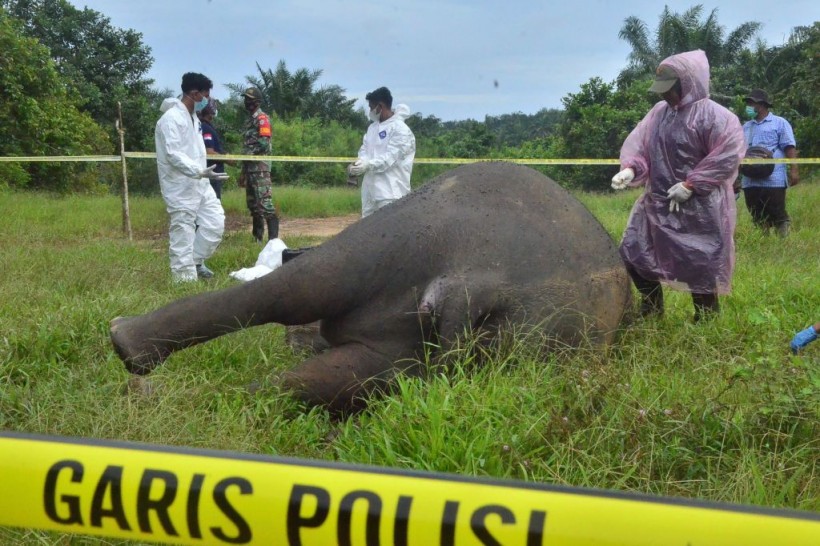DNA from African elephants' horns who are now a victim of the illicit poaching; are leading to its very crime networks that poached them.
Investigators were able to locate the transnational crime ring exporting the ivory from Africa by using Laboratory tests on ivory consignments, confiscated by police departments.
4000 Tusks Tested For Illegal Ivory Trafficking Networks

Officials work at the scene where a critically endangered Sumatran elephant was found decapitated with its tusks missing in Banda Alam, East Aceh, on July 12, 2021.
The researchers examined almost 4,000 elephant ivory seized throughout 2002 and 2019 in 49 distinct African nations, according to news published by CNN.
The discoveries were posted in the publication Nature Human Behavior on Monday. Research suggests the illegal hunting and transporting strategies, as well as the interconnectivity of the smugglers, and creates personal ties among elephants getting lured away for their elephant tusks.
In an argument, a University of Washington biology professor and co-executive director of the Center for Environmental Forensic Science and research scientist Samuel Wasser, quipped that such techniques demonstrate to the experts that a bunch of channels are behind the vast bulk of contraband elephant tusks, and that the relationships between any of these network systems are thicker than preceding analysis found.
Furthermore, recognizing close family members suggests that traffickers are probably returning to the similar communities on an annual basis, and horns are then obtained and transported out of Africa on cargo vessels by the very same crime syndicate.
The tusks were obtained from both rainforest and savannah elephants. Vast tusk deliveries, which may transport massive volumes of ivory aboard cargo vessels, are most certainly the product of a limited set of trafficking organizations.
Connecting various ivory arrests conducted at harbors hundreds of kilometers away may generate a digital footprint and bolster prosecutions towards people convicted for hunting and exporting the ivory.
This research expands on prior research released in 2018 by Wasser and associates, which revealed that ivory from the very same rhinoceros were frequently split and trafficked in several cargoes prior to getting confiscated.
However, the assertion that the divided horns were still transported out of the same port facilities assisted the investigators in determining that there were as there are less organizations transporting widespread elephant tusks consignments than initially assumed, according to Wasser.
Also read: 29,000 Turkeys Killed to Prevent a Highly Pathogenic Strain of Bird Flu in the U.S.
DNA Testing of Elephant Tusks
The experiment's 17-year timeframe also demonstrated how the connections moved to multiple destinations over time, from Tanzania, Kenya, and Uganda to Angola and the Democratic Republic of the Congo.
As per the latest research, the three systems identified in the 2018 investigation are engaged in numerous incidents and are therefore more interconnected than publicly confirmed.
"Due to the obvious great strain, they are facing to transfer huge numbers of cargo swiftly via terminals, this illegal technique renders it more difficult for regulators to follow these cargoes."
Lawbreakers are frequently associated to a single tusk cargo discovery, according to Brown, but pinpointing descendants will be a lot more prevalent occurrence, potentially linking multiple ivory arrests to the same trafficking organizations "Wasser stated.
The ivory was then exported from harbors in several nations. The current study expanded the Laboratory studies to look for rhinos who were linked in some manner, such as parents, kids, and relatives.
Also read: Fascinating Images Reveal 'Alien-Like' Eggs Containing World's Most Venomous Animal
© 2024 NatureWorldNews.com All rights reserved. Do not reproduce without permission.

![Tsunami Hazard Zones: New US Map Shows Places at Risk of Flooding and Tsunamis Amid Rising Sea Levels [NOAA]](https://1471793142.rsc.cdn77.org/data/thumbs/full/70325/280/157/50/40/tsunami-hazard-zones-new-us-map-shows-places-at-risk-of-flooding-and-tsunamis-amid-rising-sea-levels-noaa.jpg)



